IDF 2009 - Intel Shows off 22nm & 32nm, Sandy Bridge Demoed
by Anand Lal Shimpi on September 22, 2009 12:00 AM EST- Posted in
- Trade Shows
This is a big IDF, it's my first without Pat Gelsinger at Intel. We're unlikely to hear much about Pat's departure here, but the rumor mill appears active with everything from him being kicked out due to Larrabee's initial issues (unlikely) to him not being selected to be the next in line for CEO succession at Intel (much more likely).
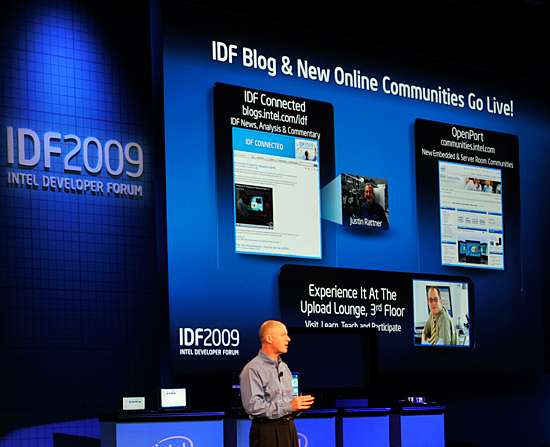
Sean Maloney, the heir to Otellini's throne at Intel - not Gelsinger
Regardless of what the motivations were, he will be sorely missed. Pat Gelsinger was the first person I met in this industry who truly blew me away with his knowledge. He has a rare combination of pure genius, passion and an incredible ability to convey even the most complicated concepts in a very easy to understand manner. He's been a tremendous influence on my own style of writing and knowledge, and for that I'll be forever grateful. Pat, you will be missed.
1B+ Transistors at 32nm, Working 22nm SRAM
Otellini gave us a status update on Moore's Law. 32nm is healthy and we'll see the first products based on Westmere later this year:
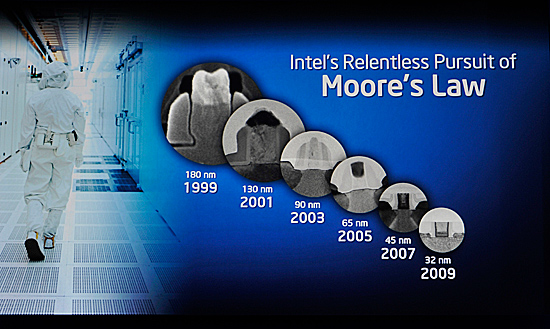
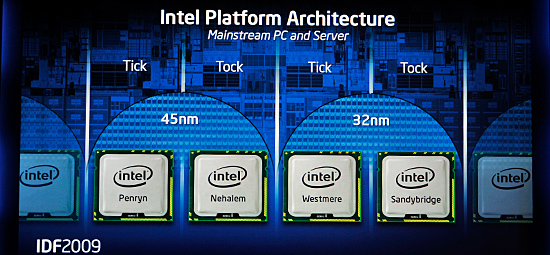
The move to 32nm will allow Intel to ship microprocessors with over 1 billion transistors into the consumer space. Sweet.
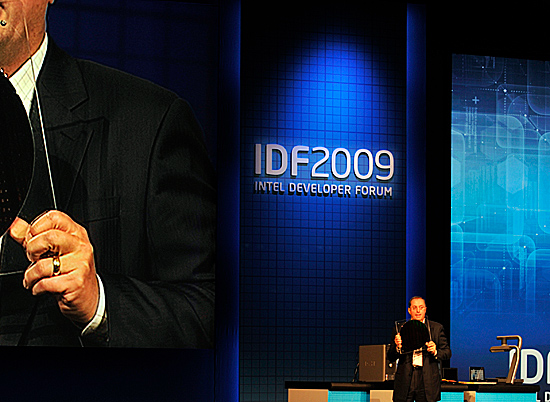
The first 22nm test wafer, fully functional
We also got the first look at Intel's 22nm SRAM test vehicle. The relevant details are as follows: 2.9 billion transistors per SRAM chip, each arey is 364Mb and production in CPUs in the second half of 2011.
Atom Gets Tick Tock, Sorta
Paul outlined the roadmap for the Atom processor and you'll notice that its progression looks a lot more like how Intel used to do things:
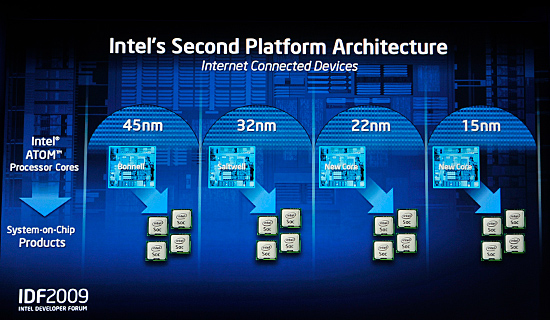
We'll get a brand new microarchitecture every "2 or so" years and transitions to smaller manufacturing processes on a regular basis.
Bonnell is the current 45nm core, Saltwell is the 32nm follow-up due out next year.
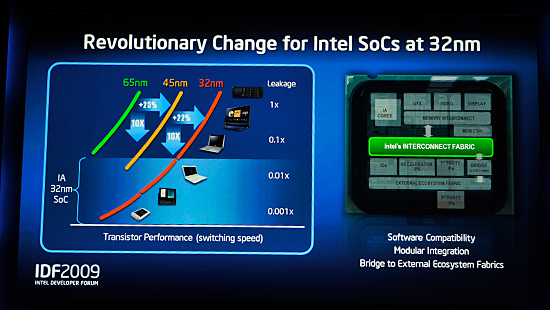
The move to smaller transistors ultimately has a different focus in the Atom space. While smaller manufacturing processes can be used to ramp clock speeds, in Atom the focus is going to be to reduce leakage current (and thus improve power efficiency/battery life). We'll see larger caches, more integration, but not necessarily higher clock speeds out of Atom in the future. Intel's goal here is to get Atom power consumption down to ARM levels.
Arrandale and Sandy Bridge Demos
An IDF keynote wouldn't be an IDF keynote without a demo of at least some unreleased CPU.
First up was Arrandale, the upcoming dual-core 32nm Westmere derivative. We got a demo of an Arrandale notebook running full disk encryption accelerated by the CPU's hardware AES instructions.
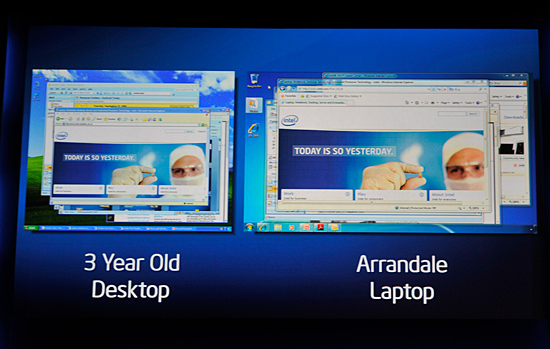
Sandy Bridge is the next major architecture shift due out in the second half of 2011. Built on 32nm, Sandy Bridge should be to Nehalem what Nehalem was to Conroe. It will also be the architecture that competes with AMD's long awaited Bulldozer cores. If all stays on track, 2011 should be very competitive in the high end CPU space.
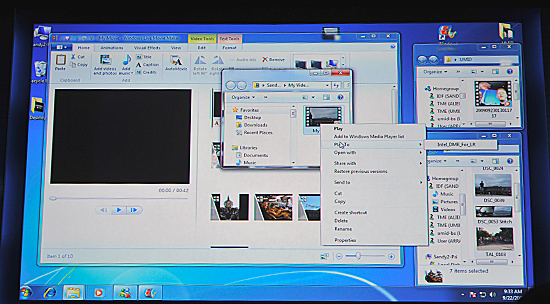
Sandy Bridge running Windows 7 and transcoding video already
The Intel Atom Developer Program
Intel announced the Atom Developer Program and its first three partners: ASUS, Acer and Dell.
The program is a way of encouraging development for Atom based platforms (and potentially testing the waters of moving people off of ARM and to x86 in the ultra mobile space).

ASUS CEO, Jonney Shih
ASUS' CEO Jonney Shih was present via pre-recorded video to pledge ASUS' support for the Atom Developer Program. Mr. Shih also announced ASUS' Eee App Store, for users to develop applications for Atom based Eee devices from ASUS.
Moblin 2.1 Demo
Moblin is a mobile optimized Linux distribution designed for notebooks, but next year we'll start seeing it on MIDs (again, one step away from getting Atom ready for the smartphone).
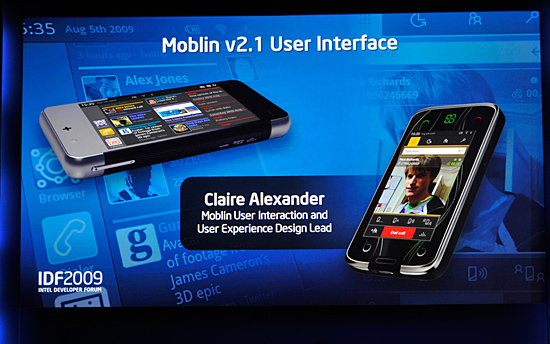
Intel did a quick demo of the Moblin 2.1 UI on a MID. The UI isn't particularly amazing by smartphone standards, but it's getting there. One more generation and I think we might have something that could really be used in a smartphone.
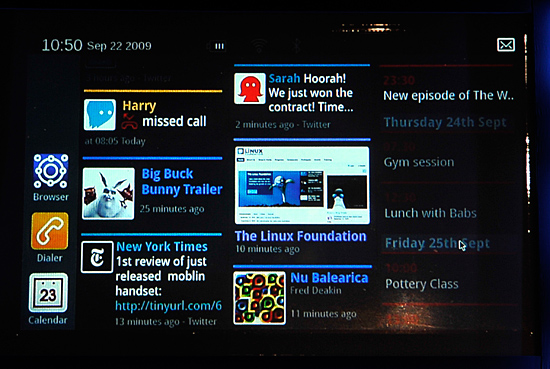
Intel's goal here is to bring the netbook usage experience to the MID. Honestly, that's been the biggest limitation to MID adoption in my mind: scaling down a desktop UI to a 5" screen just doesn't work well. A brand new touch UI is necessary for MIDs to be useful and Moblin delivers just that.
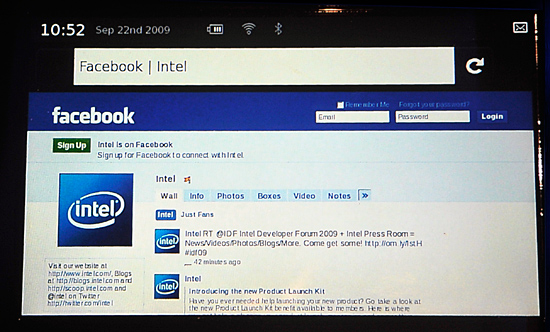

You can give Moblin a try on your netbook here.










34 Comments
View All Comments
TA152H - Wednesday, September 23, 2009 - link
Are you an idiot?Does the Lynnfield have the G45? That's my point, bonehead. I'm not saying the Core 2 makes no sense (although, many don't at the price they are at), but the Lynnfield because it has NO IGP. Get it now.
For what it's worth, I prefer, as a company, Intel to AMD. Mainly because Intel is American, and I don't know what AMD is anymore. I loved Jerry Sanders, but I hate Hector Ruiz.
Also, Intel invented the microprocessor, and at least tried to kill x86. So, I do like Intel, but that's really got nothing to do with anything. That's probably why you think I prefer AMD. I don't let personal opinions like that influence my opinions on products.
I just think AMD did a better job with their marketing of the quad-core Athlon. Also, I'm frustrated because I want to buy a nettop, but Intel still doesn't have a suitable chipset. Haven't they had enough time?
Penti - Saturday, September 26, 2009 - link
Actually Intels next-gen on-package GPU will be based of G45. You don't like AMD anymore because their manufacturing arm is based in Germany and owned by the American ally UAE/Abu Dhabi? Seems retarded as they're putting in billions to build a fab in New York. It's not like all Intel fabs is in the US. Just buy a S775 Mini-ITX with nVidia 9300 and a suitable C2D-based cpu for now if you like some small nettop like computer with more performance, there's also some other ION based stuff on the market if you like an OEM-computer. (LikeEeeBox PC EB1012)
CSMR - Tuesday, September 22, 2009 - link
Intel is about to modernize the Atom chipset with Pineview.pwnsweet - Tuesday, September 22, 2009 - link
I was really looking forward to info on Pineview, but it looks like there's nothing. I've been holding out for months on buying a netbook, waiting for more info on Pineview to surface (it's effect on battery life mainly).Lonyo - Tuesday, September 22, 2009 - link
I'd have to agree.Intel are pushing the boundaries, kind of, in the higher end, but the new chips (especially the i5) don't offer a huge leap over existing quad core products, unless you consider things like overclocking.
There seems to be little real development in terms of Larrabee.
AMD may not be pushing the high end, but they have quad cores for $100, they are about to unveil their new graphics architecture, they have a solid desktop platform.
AMDs main stumbling block IMO at the moment is in the mobile space. With improved CPUs they could have a brilliant platform offer, but CPU power consumption isn't ideal at the moment, which is a shame, but AMD still haven't caught up while Intel are doing nothing in the mobile arena.
Intel have lots of positive products, but it just feels like they are somewhat lacking. They are fast, they get faster, but there's no real game changing element to introducing a new higher priced offering all the time.
I'm quite happy with my sub $100 quad core chips, my triple monitors from one consumer level graphics card, and if they get round to it, a nice laptop platform.
If it wasn't for overclocking, I'd probably be using AMD in my desktop (yay for E5200 @ 3.4GHz on cheap mobo+ram), and the main issue I have with my laptop is poor battery life, but then it was a fair bit cheaper than comparable Intel laptops, so those are the sacrifices.
IntelUser2000 - Tuesday, September 22, 2009 - link
Actually, they do realize how important the IGP in the market is, but they are not going to include that with the Lynnfield quad cores. I mean, they are supposed to be high end. It's a little disappointing that quad core users won't get an IGP option, but how many did before anyway?TA152H - Tuesday, September 22, 2009 - link
You're kind of confused, I think.High end machines are not always machines that need video. I use my high end machine for compiling. How much video power do I need. A place I worked at used high end machines for computation fluid dynamics? How much video did they need? Zero.
There are a lot of instances where you have high computational needs, but not high graphical needs. And, many of these, you don't have the desire to use up a slot, and use extra power for a discrete card. Or the cost, if you buy 1000s of them, like many companies do.
Most quad cores DID have the option. The only ones that didn't were the Bloomfield. The Core 2 does. All the AMD chips can be had on a platform with an IGP. Bloomfield is a high end product, and I can almost understand Intel for not putting an IGP there, but like I said, there are uses. It's also harder to do with an IMC, since you can't use the memory controller on the NB anymore. But, anyway, for the Lynnfield, which is a brain-damaged, stripped down version of the Bloomfield, you're now moving into a lower price segment. In this price segment, you're really going to see a lot more interest in the IGP. The i5 750 almost screams for it.
There just seems to be a disconnect between Intel's different parts. They seem to be doing well with the processors, but the platforms seem to be lagging a bit. As we all know, you can't sell the processor without the platform, so I think Intel is hurting themselves.
If I had to recommend a home machine, and I do fairly often, I would either recommend a dual core Core 2, or Athlon. The Athlon has such an attractive platform, it can really be as important, or more, than the processor itself. Most processors are fast enough for people, but, most people always like to save money, and the G45 isn't really powerful enough. To put it another way, there are more times a G45 will hold you back, than a $100 quad core Athlon.
ilkhan - Wednesday, September 23, 2009 - link
The lack of an IGP in lynnfield is a consequence of their moving it to the CPU and wanting to keep lynnfield's price down. They could have put a GPU in it, but it would have added die size, complexity, and heat. Would you rather all lynnfields be $30 more expensive, or would you you keep the $30 savings and use a $30 cheapy PCI-E GPU when its needed and put the $30 towards a gaming GPU when your client needs that?Worry not, as soon as sandy launches quads will have iGPU options as well again. And with sandy it'll be one die, moving the GPU there for the first time and the IMC gets to move back to the CPU die.
TA152H - Wednesday, September 23, 2009 - link
You realize you can put an IGP in the chipset, right? They could have done that, or, waited until 32nm to release this type of chip. It's not too far away, and it wouldn't create the market confusion the Lynnfield has.More to the point, the Lynnfield is overpriced. Well, the P55 is. Why does it cost so much? There's almost nothing to do it. Why does it cost as much as the P45? No memory controller, no PCIe, but it costs the same. The platform doesn't make a lot of sense at the price it's at.
Intel made a Celeron platform, which is all the Lynnfield is, except it's even more compromised, but it hasn't settled into its proper spot. It costs too much, it doesn't have the IGP, and it doesn't make any sense right now. When they move the Celeron (which I'll call the Lynnfield and succeeding platforms) down in price, get rid of the Core 2, and give it an IGP, it will be like the old 300 MHz Celeron A. It will be REALLY attractive for a lot of people, and you'll have real market separation between it and the real i7, particularly with the six core processors.
Right now, it's just a mess. The market segmentation is just wrong, and that's why these things aren't selling. They're a good idea, and long term should do great when everything is ready, but as is, it's just not a Bloomfield, and tries to act like it is.
Happy2BeHere - Tuesday, September 22, 2009 - link
Amazing!It was obvious in all the recent Lynnfield core i5/core i7 articles, and I just read both of the IDF 2009 articles, and, unbelievably, the trend continues...
What everyone is wondering: Can TA152H ever make it through an entire thread without using the phrase "brain-damaged"?
Frankly, I doubt I'll see it in my lifetime...